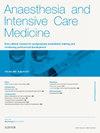床边强离子分析
IF 0.3
Q4 ANESTHESIOLOGY
引用次数: 0
摘要
Stewart的人体酸碱生理学定量理化模型填补了临床酸碱分析与一般流体生理学之间的空白。物理化学模型经常被认为过于复杂,不适合床边使用,然而,一组基于Stewart模型的简化筛选问题可以用来帮助酸碱解释。重点是了解低白蛋白血症的酸碱后果,容量状态,强直性和氯化物,因为这些在重症监护病房患者中很常见。本文章由计算机程序翻译,如有差异,请以英文原文为准。
Strong ion analysis at the bedside
Stewart's quantitative physicochemical model of human acid-base physiology filled a void between clinical acid–base analysis and general fluid physiology. The physicochemical model is frequently perceived as too complex for bedside use, however a set of simplified screening questions based on Stewart's model can be utilized to aid acid–base interpretation. Emphasis is placed on understanding the acid–base consequences of hypoalbuminaemia, volume status, tonicity and chloride as these are common in intensive care unit patients.
求助全文
通过发布文献求助,成功后即可免费获取论文全文。
去求助
来源期刊

Anaesthesia and Intensive Care Medicine
ANESTHESIOLOGY-
CiteScore
0.50
自引率
0.00%
发文量
152
期刊介绍:
Anaesthesia and Intensive Care Medicine, an invaluable source of up-to-date information, with the curriculum of both the Primary and Final FRCA examinations covered over a three-year cycle. Published monthly this ever-updating text book will be an invaluable source for both trainee and experienced anaesthetists. The enthusiastic editorial board, under the guidance of two eminent and experienced series editors, ensures Anaesthesia and Intensive Care Medicine covers all the key topics in a comprehensive and authoritative manner. Articles now include learning objectives and eash issue features MCQs, facilitating self-directed learning and enabling readers at all levels to test their knowledge. Each issue is divided between basic scientific and clinical sections. The basic science articles include anatomy, physiology, pharmacology, physics and clinical measurement, while the clinical sections cover anaesthetic agents and techniques, assessment and perioperative management. Further sections cover audit, trials, statistics, ethical and legal medicine, and the management of acute and chronic pain.
 求助内容:
求助内容: 应助结果提醒方式:
应助结果提醒方式:


